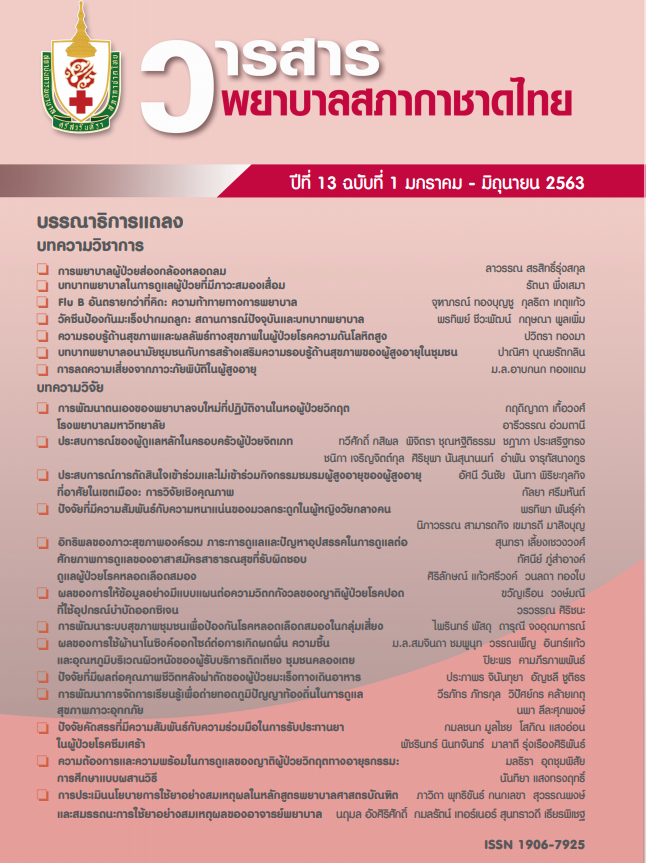The Effects of Using Nano-Zinc Oxide Fabrics on Bed-Ridden Patients’ Skin Rash, Moisture and Temperature in the Klongtoey Area of Bangkok.
Keywords:
Nano-zinc oxide fabrics, skin rash, moisture, temperature, bed-ridden patientsAbstract
This quasi-experimental research aimed to study the incidence and duration of rash on the skin of bedridden patients. The moisture and temperature on bedridden patients’ skin were compared between nano-zinc oxide bed sheets and normal bed sheets. The 62 bedridden patients were divided into 2 groups - 31 patients who received normal care with nano-zinc oxide bed sheets as the experimental group and 31 patients who received normal care and normal bed sheets as the control group. Data were collected by using a general data questionnaire, assessment form for skin rash, and skin moisture and temperature data records for the back, hips and legs at days 1, 3, 5, 7, 9, 11, and 14. The data were analyzed for incidence values. The moisture and temperature values between the control and experimental group were analyzed with repeated measures ANOVA.
The results of the research revealed the following:
1. After the experiment, there was no incidence of rash on the skin of neither the control nor the experimental groups.
2. The skin rash for the back, hips and legs of 7 subjects - 5 from the experimental group and 2 from the control - which appeared before the study disappeared and turned to normal within 4-8 days for the experimental group, while the ones in the control group still remained throughout the study period.
3. The mean score of skin moisture for the back and hips and the mean score of skin temperature for the back, hips and legs of the experimental group were statistically significantly better than those of the subjects in the control group (p < .05).
It appears that nano-zinc oxide bed sheets can reduce moisture for the back and hips, the areas where the rash most often appears; moreover, it can reduce temperature for the back, hips and legs. However, further research should include nano-zinc fabric to more subjects or include the use of clothing for bedridden patients.
References
2. Bliss DZ, Savik K, Thorson MA, Ehman SJ, Lebak K, Beilman G. Incontinence associated dermatitis in critically ill adults: time to development, severity, and risk factors. J Wound Ostomy Continence Nurs 2011;38(4):433-45.
3. Bliss ZD, Funk T, Jacobson M, Savik K. Incidence and characteristics of incontinence associated dermatitis in community-dwelling persons with fecal incontinence. J Wound Ostomy Continence Nurs 2015;42(5):525-30.
4. Kaewkab U, Chanruangvanich W, Thosingha O, Suporn Danaidutsadeekul S. The Effects of Utilizing Clinical Nursing Practice Guidelines for Prevention of Perineal Dermatitis in Neurological Patients with Urinary Incontinence. Journal of Nursing Science 2012;29(4): 37- 45. (in Thai).
5. Wongprasert A. Evidence based nursing practice: Perineal skin care in urinary and/or fecal incontinence patient. Nursing Science Journal of Thailand 2006;24 (3):35-44. (in Thai).
6. Thaipradit S, Sae-Sia W, Traniwattananon P. Impact of a skin humidity control programme on skin integrity and pressure ulcers in elderly patients with pressure ulcer. Thai Journal of Nursing Council 2014;29(1):43-54. (in Thai)
7. Keawkhong N. The development on antibacterial fabric on textile materials [Master Thesis of Master of Science]. Pathum Thani: Rajamangala University of Technology Thanyaburi; 2014. (in Thai)
8. Chooseng K, Jongchit M, Surapantapisit Y, Hotakovit W. Effects of using nano technology for chef’s uniform affecting on food safety. Rajamangala University of Technology Phra Nakhon; 2012. (in Thai).
9. Saeng-ngam A. Textile and nanotechnology.Journal of Science and Technology 2013;5(5):17-20. (in Thai).
10. Pholnak C. Zinc oxide nanoparticles with antimicrobial activity. Thai Journal of Physics 2017;34(3-4):37-47. (in Thai)
11. Williams C. Examining the range of medicated and paste-impregnated bandages. Br J Nurs 1999;8(15):1019-20.
12. Wiegand C, Hipler UC, Boldt S, Strehle J, Wollina U. Skin-protective effects of a zinc oxide-functionalized textile and its relevance for atopic dermatitis. Clin Cosmet Investig Dermatol 2013;6:115-21.
13. Neamjan N. Effect of various shapes of ZNO nanoparticles on cotton fabric via electrospinning for anti-UV and anti-bacterial properties [Master Thesis of Master of Engineering]. Bangkok: Silpakorn University; 2010. (in Thai)
14. Jinaporn J, Temtap S, Nilmanat K. Comparison of petroleum-based skin-protection product and zinc oxide-based skin-protection product on incidence and the level of severity of early incontinence associated dermatitis in hepatic encephalopathy patients with incontinence. Journal of Public Health Nursing 2018;32(2):60-79. (in Thai)
15. Ashraf M, Siyal MI, Nazir A, Rehman A. Single-step antimicrobial and moisture management finishing of PC fabric using ZNO nanoparticles. AUTEX Research Journal 2016;17:1-4. doi: 10.1515/aut-2016-0023
16. Agren MS. Wound healing biomaterials. Volume 2: functional biomaterials. Cambridge: Woodhead Publishing; 2016.
Downloads
Published
Issue
Section
License
เนื้อหาบทความหรือข้อคิดเห็นต่างๆ ในวารสารพยาบาลสภากาชาดไทยนี้ เป็นความคิดเห็นของผู้เขียนบทความ ไม่ใช่ความเห็นของกองบรรณาธิการ หรือสถาบันการพยาบาลศรีสวรินทิรา สภากาชาดไทย






